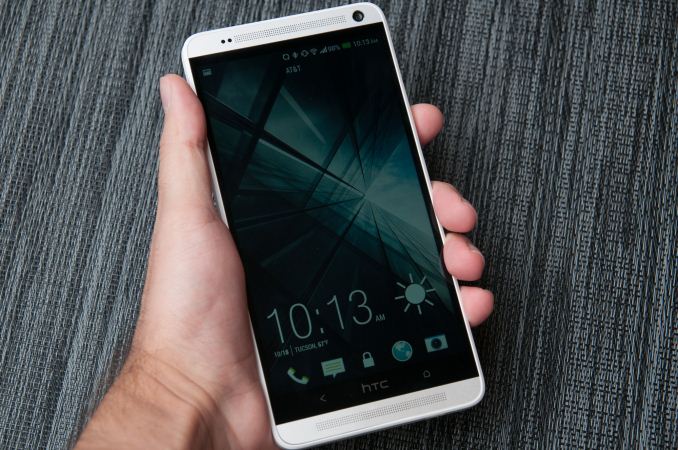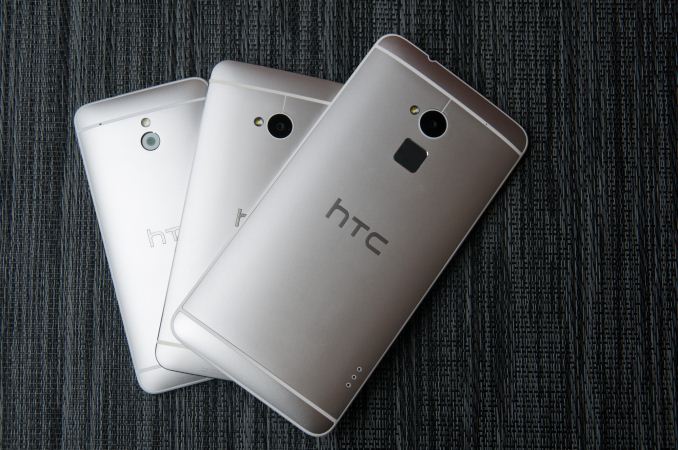HTC One max Review - It's Huge
by Brian Klug on October 28, 2013 10:00 AM EST- Posted in
- Smartphones
- HTC
- Mobile
- One
- Snapdragon 600
- Android 4.3
- One max
Concluding the One max review is difficult. I have a lot of conflicting thoughts about the larger sized smartphones and the state of that market, which seems to serve two purposes independently. For users who either don’t want or can’t budget for a tablet, the larger sized phones seem to bridge a functional gap between smartphone and tablet. Simultaneously, there are users who want the larger screen just to have it, and maybe there’s the perception that the larger phones still have some elevated status that comes with it. There’s a regional bias at play here too, and the One max seems to be a product designed to cater maybe more to some regions where supersized smartphones make up a bigger part of the market than others.
For me, the One max is probably a new upper bound in terms of size. It’s a very large phone, and although it fits in the front pockets of my jeans and shorts, it’s sometimes a stretch to sit down comfortably with the One max in a pocket. In terms of ergonomics, the One max is very much a dual-hand device.
The One max is really a product designed to fill out a hole in HTC’s One series portfolio than anything else, and doesn’t really change up the formula too much. It’s literally a scaled up version of the HTC One with few changes – OIS is unfortunately gone, the screen is obviously huge, there’s now a microSD card slot, and of course the new fingerprint sensor. Other than that though, the One max really is the One scaled up to gigantic size, with parts of the One mini tossed in for good measure.
I’ve said my part on the fingerprint sensor on the One max already. It works but isn’t the best or most intuitive implementation to date, although I think it’s fairly easy to make the case that nobody, not even Apple, has nailed a fingerprint sensor yet. The fingerprint scanner’s location on the back makes sense when you’re holding the One max in one hand, but becomes a problem when you’re using the phone on a flat surface. The use of a swipe sensor as well makes positioning on the back somewhat problematic unless you enroll fingers at a natural angle.
There’s also that elephant in the room about platform, specifically HTC’s inclusion of Snapdragon 600 APQ8064T instead of the faster Snapdragon 800 MSM8974 we’re seeing devices start shipping with right now. Although 8064 is still plenty fast and no slouch, there’s still a perceptible performance delta between an 8064 device and the newer 8974 phones I have on my desk now. I worry a lot about whether HTC will fall behind on platform, especially since it used to be the one OEM always shipping new Qualcomm silicon first. I have a feeling the One max saw platform change at the last minute, delaying its launch, but that's almost entirely speculation.
If you want a larger-screened smartphone and liked the One but have been waiting for a long time for the One max, by all means, get it. If you want a larger screened smartphone however, I think it’s easy to make the case that there are better devices out there right now. Had the One max arrived a month or two after the launch of the original One, this conclusion would've likely been a very different one.













197 Comments
View All Comments
ddriver - Monday, October 28, 2013 - link
The note 3 is not really flat, the camera bulges a little bit, but yes, the overall shape of the back cover is flat. It is modular and replaceable though which does open a bit of customization option.kertisoka - Monday, October 28, 2013 - link
I don't think that the camera bulge is a plus though..ddriver - Monday, October 28, 2013 - link
A shame really, they could have put a much better sensor and optics in such a thick body...beginner99 - Monday, October 28, 2013 - link
Well the One and One Mini were already pretty oversized too in comparison to other models with the same screen size so nothing new (and IMHO bad). I like the design but the screen is too small or the chassis too big.FunBunny2 - Monday, October 28, 2013 - link
Ya want stereo speakers on the front? well, until they make speakers that play through the screen, physics will be physics.Omega215D - Tuesday, October 29, 2013 - link
The BoomSound speakers and the different shell thickness/ weight compared to the Samsung. Samsung uses thinner shells in order to achieve their svelt bodies and lighter weight. Also depends on the display technology used. LCDs are heavier than OLEDs.heron_kusanagi - Monday, October 28, 2013 - link
Hi Brian,Could you please do a Nokia Lumia 1020 review?
Drumsticks - Monday, October 28, 2013 - link
I'd also love to see a modern windows phone review. The 1520, personally. I mean, we got a Z10 review didn't we?If nothing else, id love to see a dive into Nokia's imaging on the 1020 and 1520, which is some engineering that I think everyone should be capable of appreciating, no matter how much you dislike the OS.
Alexvrb - Monday, October 28, 2013 - link
Yeah, I'd also like to see a proper 1520 review. I'm not surprised nobody at Anandtech got an invite to Nokia's event. Keep tossing their review phones in a closet (trash can?)... I'd quit sending you anything, if it was up to me. Waste of time and money.On the other hand, since he hates WP, it might just end up being a big ol' take a dump on the WP device article.
kyuu - Monday, October 28, 2013 - link
+1